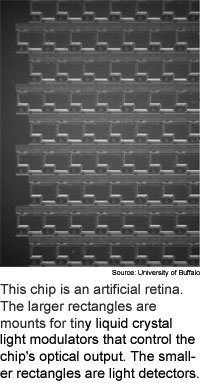
Vision chip shines
By
Eric Smalley,
Technology Research NewsThe video cameras and complicated image processing software that are used to give machines the ability to see are relatively bulky and expensive. Many research teams are working toward a better solution -- eyes-on-a-chip.
Researchers from the State University of New York at Buffalo and Stanford University have built a silicon retina that uses a timing signal to mimic a form of data compression performed by biological eyes, and transmits high-speed optical rather than electrical output.
The silicon retina could be used to give small robots a better understanding of their visual environment, according to Albert Titus, an assistant professor of electrical engineering at the State University of New York at Buffalo. The electronic retina could also be used in smart sensors and remote monitoring cameras, where its ability to sort out important information would allow reduced amounts of data to be analyzed, transmitted and stored.
Like its biological forerunners, the electronic retina processes the larger amount of data that makes up an image in order to transmit a smaller amount of key information. The silicon retina provides information about the edges of images rather than a whole picture. Edge information is usually sufficient for detecting and tracking objects.
The device's pixels are an array of light detectors made from metal oxide semiconductor. The array takes in an image, processes the information, and passes the compressed output to a liquid crystal spatial light modulator on the chip. Spatial light modulators pattern light, in this case allowing it through in positions corresponding to pixels that generate an electrical "on" signal.
The spatial light modulator enables output from each receptor, or pixel, to be transmitted optically, which allows the process to take place nearly in real-time. "Optical output... allows for maximum parallelism of the data output, and requires no wires to send the data," said Titus.
Otherwise, with electrical output, an array of 4,096 pixels would require 4,096 output wires from the chip, or it would have to slow down the process by sending more than one output per wire, said Titus. "These are both unrealistic approaches," he said.
Biological retinas use two types of light receptor cells -- rods and cones -- to convert optical energy into electrochemical responses that can be processed by nerve cells. Cones are sensitive to color, and work best in bright light. Rods allow for vision in dim light.
Three other types of cells -- amacrine, bipolar and horizontal -- work together to share signals between receptors, and to transmit the signals to nerve cells. The result is the light pattern the retina picks up gets transformed, or filtered, into a more concise set of information for the ganglion cells that make up the optic nerve, said Titus. "There are anywhere from 10 to 1,000 [times] fewer ganglion cells than receptors, so there is a significant amount of data compression that occurs between the light input and what is transmitted to the brain," he said.
One form of retinal data compression is "a response that corresponds to the edges of objects," said Titus. "If you break an input image into objects represented by just their edges -- changes in intensity -- then you remove a lot of information from the image, but you still have quite a bit of information about the scene," he said.
The researchers' design models the function of the receptors and the bipolar, amacrine and horizontal cells, said Titus. "Our silicon retina produces information about the edges and performs edge enhancement based on motion," he said.
Edge detection is a common capability of artificial retinas. The researchers' design is unique because it uses a clock signal to synchronize the pixels, which allows the chip to work efficiently, according to Titus. A pixel in the artificial retina is about 10 times faster than a photoreceptor in a biological retina, so it can perform several operations for every photoreceptor operation, said Titus. This helps the artificial retina perform edge detection using a relatively small number of pixels, he said.
The chip also draws very little power. Each cell requires less than one ten thousandth of a Watt to turn on and off at speeds of a few kilohertz, or thousand times a second.
The researchers have built a prototype that contains 256 pixels, and are working to make a more complete silicon-based system that can be used in autonomous robots and smart sensors, said Titus. They're also aiming to use the silicon retina in cameras for remote monitoring for safety, identification and biometrics purposes, he said.
The researchers are also working on artificial retinas that do more than just edge detection, said Titus.
The silicon retina could be used in practical applications within one to five years, according to Titus. Applications using optical output will have to wait 10 years or so until optical interconnects are available for interchip communications, he said.
Titus's research colleague was Timothy J. Drabik. The work appeared in the August, 2003 issue of Optical Engineering. The research was funded by Displaytech, Inc.
Timeline: 1-5 years, 10 years
Funding: Corporate
TRN Categories: Computer Vision and Image Processing; Optical Computing, Optoelectronics and Photonics
Story Type: News
Related Elements: Technical paper, "Optical Output Silicon Retina Chip," Optical Engineering, August, 2003.
Advertisements:
September 10/17, 2003
Page One
Display brighter than film
Sponges grow sturdy optical fiber
Electron teams make bigger qubits
Vision chip shines
News briefs:
VR system grabs 3D video
Quantum computing has limits
Gold speck highlights molecules
Neural net tracks skin color
Nano thermometer withstands heat
Light drives electron logic

News:
Research News Roundup
Research Watch blog
Features:
View from the High Ground Q&A
How It Works
RSS Feeds:
News
Ad links:
Buy an ad link
| Advertisements:
|
 |
Ad links: Clear History
Buy an ad link
|
TRN
Newswire and Headline Feeds for Web sites
|
© Copyright Technology Research News, LLC 2000-2006. All rights reserved.